 | Электронный компонент: AND8031 | Скачать:  PDF PDF  ZIP ZIP |
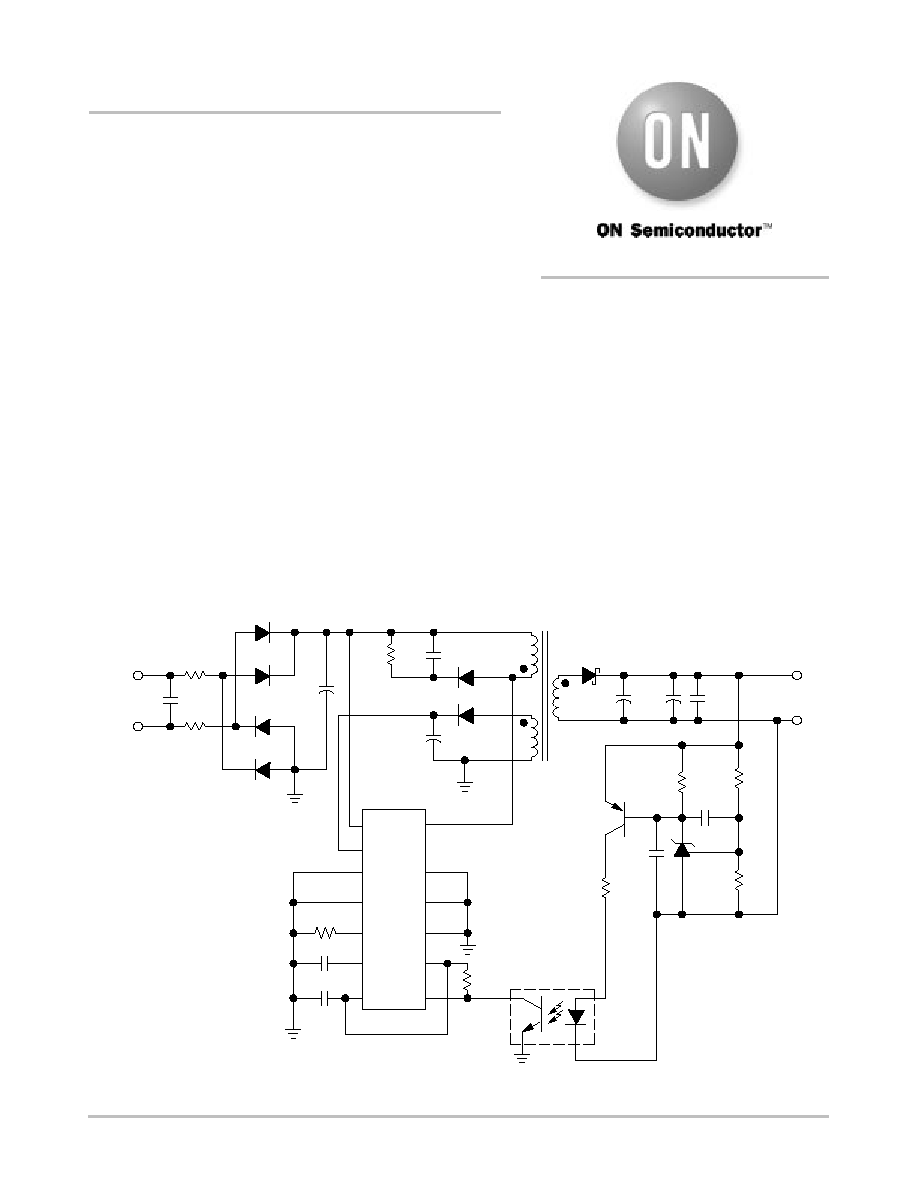
⌐
Semiconductor Components Industries, LLC, 2000
October, 2000 ¡ Rev. 1
1
Publication Order Number:
AND8031/D
AND8031/D
Isolated Precision
Regulation of a Single
1.8 Volt Output from a
Universal Line Input
Prepared by: Jason Hansen
ON Semiconductor
INTRODUCTION
The following Application Note describes an off¡line
switching power supply utilizing a precision programmable
reference to regulate a 1.8 volt output. The center of the app
note is the MC33363B, a monolithic SMPS controller with
a 700 volt power switch, and the NCP100, a sub¡one volt
precision programmable reference. The system design and
analysis will be described in detail.
The design requirements are for a universal off¡line
converter with a 1.8 volt, 1.0 ampere single output with less
than 50 millivolts ripple and operates at 100 kHz. Most of the
components selected are surface mount. This design is
separated into the generic circuit of the off¡line converter
and the feedback network.
Generic Off¡Line Conversion Circuit
To reduce the total number of components and thus
minimize circuit board area, an SMPS controller with an
integrated power switch is selected. With the low output
power requirement, the MC33363B is selected as the control
and power switch IC. The MC33363B contains an externally
programmable frequency and current limit, internal startup
circuit and can handle up to 8 watts of output power.
The basic off¡line conversion circuit is illustrated in
Figure 1. The line input is filtered through the EMC circuit
then rectified and filtered. The rectified voltage is converted
to a lower voltage via the transformer and the MC33363B.
The secondary of the transformer is rectified to a DC voltage
and filtered. The output voltage controls the duty cycle of the
switcher via the isolated feedback network. The calculated
values are a starting point and do not replace bench testing.
Figure 1. MC33363B Basic Flyback Circuit Schematic
1
3
4
5
6
7
8
16
13
12
11
10
9
MC33363B
Universal
Input
1N4005
R2
4.7
R1
4.7
C1
1 n
D1
D2
D3
D4
U1
4.7
╡
400 V
R4
3.9 k
C6
10
╡
D6
MURS120
D5
MURS160
C5
47 p
R6
2.7 k
R3 30 k
C3
390 p
C4
1
╡
U3
SFH615¡4
C10
1
╡
U4
NCP100
R10
7.5 k
R9
12 k
C9
0.1
╡
R12
120
R11
10
Q1
BC858ALT1
D7
MBRD835L
C7
820
╡
+
¡
1.8 V
C8
820
╡
C12
1
╡
U2 CTX22¡14966
http://onsemi.com
APPLICATION NOTE
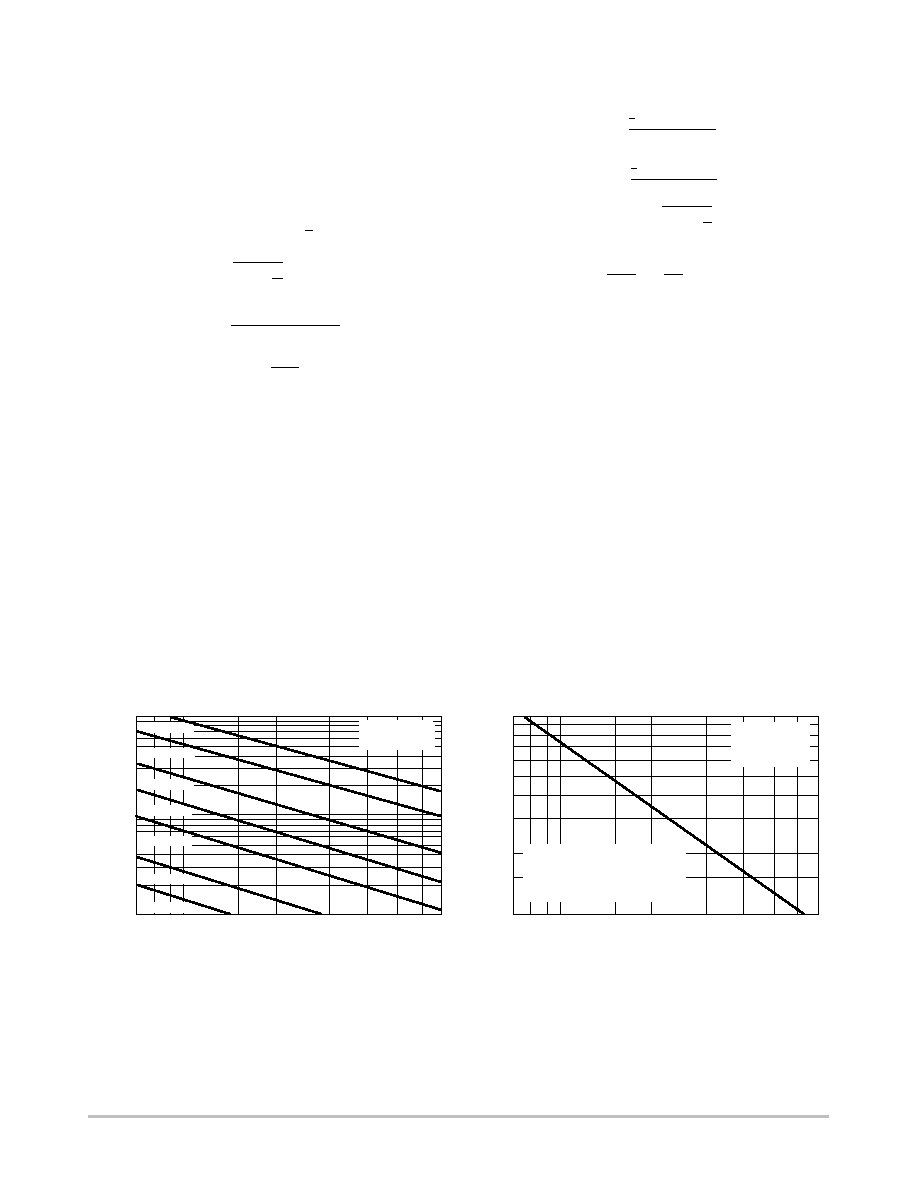
AND8031/D
http://onsemi.com
2
Since the power level is low, an RC EMC filter is utilized.
The RC filter is not as efficient as an LC, but it uses less
board area and will cost less. 1N4005 600 volt fast diodes
provide the full wave rectification of the AC input. The bulk
capacitor is the filter. The selection of the capacitor is
determined from three factors: input voltage, ripple current
and maximum output ripple. The equations for each are as
follows.
Vdc
+
Vac ╖
2
(eq. 1)
Irms
+
Ipk2 ╖ D
3
(eq. 2)
(Discontinuous
mode only)
Cin
+
k ╖ Pin (AV)
f ╖ (Vripple (p¡p))2
(eq. 3)
Pin
+
Pout
h
(eq. 4)
Where k is 1 for AC inputs the peak to peak ripple is 6.0
volts and
is estimated to be 70% with the low power level
of the board and the RC input filter. Solving for the equations
above and using 50% for the maximum duty cycle, Vdc
maximum is 375 volts, Vdc minimum is 120 volts, Ipeak and
Irms are solved for in the transformer calculations, Pin is 3.2
watts, and Cbulk is 0.9 uF.
(1)
The transformer converts the rectified line voltage to the
output voltage and is controlled by the MC33363B. To
design the transformer, the following data is necessary. Vdc
minimum is 100 volts (allowing for bulk voltage ripple and
power switch voltage drop), the frequency is 100 kHz, the
maximum duty cycle of the power switch and the reset time
for the secondary are both 45% to maintain discontinuous
conduction, and the secondary diode forward voltage drop
is 0.45 volts (estimated).
Psec
+
(Vout
)
Vdiode) ╖ Iout
(eq. 5)
Pin
+
1
2
(Vdc ╖ Ton)2
Lpri ╖ T
(eq. 6)
, or
Lpri
+
1
2
(Vdc ╖ Ton)2
Pin ╖ T
(eq. 7)
Ipeak
+
2 ╖ P ╖ T
L
(eq. 8)
Lpri
Lsec
+
Np
Ns
2
(eq. 9)
For the primary side of the transformer, Lpri is 3.16 mH,
Ipeak is 142 milliamperes, ton is 4.5 usec and Irms is 55
milliamperes¡rms. For the secondary, Psec is 2.25 watts, L
is 2.28 uH, Ipeak is 4.44 amperes and Irms is 1.72
amperes¡rms. The turns ratio is 37.2. The auxiliary winding
is set to 12 volts and 10 milliamperes. Using the secondary
turns ratio, the auxiliary turns ratio is calculated as 6.6 in
reference to the primary.
With the peak primary current and the frequency
determined, the components surrounding the MC33363B
can be selected. Referring to Figures 2 and 3, RT will be set
to 30 k Ohms and CT will be set to 390 pF. The Over Voltage
Protection, pin 11, will not be used. Its main function is for
loss of optocoupler protection. Pin 8, the reference voltage,
requires a 1.0 uF ceramic capacitor for stability. The voltage
compensation and voltage feedback, pins 9 and 10, will be
covered in the feedback section of this document. The Vcc
pin requires a 10 uF capacitor for stability.
1.0 M
7.0
R
T
, TIMING RESISTOR (k
)
500 k
200 k
100 k
50 k
20 k
10 k
10
15
20
30
50
70
R
T
, TIMING RESISTOR (k
)
0.1
0.8
0.6
0.4
0.2
0.15
7.0
10
15
20
30
40
70
50
0.3
1.0
Figure 2. Oscillator Frequency
versus Timing Resistor
Figure 3. Power Switch Peak Drain Current
versus Timing Resistor
Inductor supply voltage and
inductance value are
adjusted so that I
pk
turn¡off
is achieved at 5.0 ms.
V
CC
= 20 V
C
T
= 1.0 mF
T
A
= 25
░
C
V
CC
= 20 V
T
A
= 25
░
C
C
T
= 100 pF
C
T
= 200 pF
C
T
= 500 pF
C
T
= 1.0 nF
C
T
= 2.0 nF
C
T
= 5.0 nF
C
T
= 10 nF
f
OS
C,
OSCILLA
T
OR FREQUENCY (Hz)
I
PK,
POWER SWITCH PEAK DRAIN
CURRENT (A)
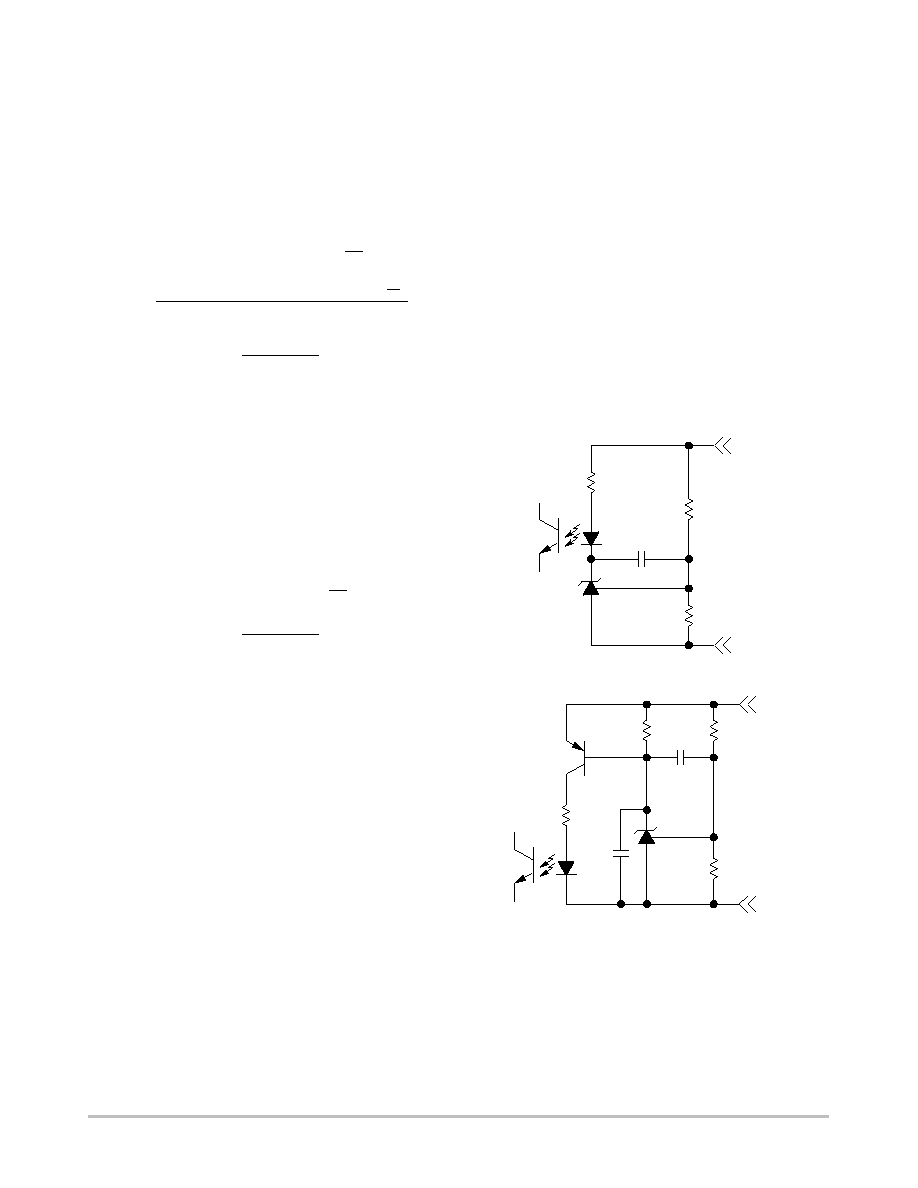
AND8031/D
http://onsemi.com
3
A snubber is required across the primary winding because
of the leakage inductance. An RCD snubber is implemented.
The diode will be an MURS160 ultrafast diode. The resistor
and capacitor are dependent upon the leakage inductance of
the primary windings of the transformer. Preliminary values
of the resistor and capacitor are derived from the following
equations. The final values will be determined on the bench
with an examination of the trade¡offs between system
efficiency and peak voltage.
Vreflect
+
(Vout
)
Vdiode) ╖
Np
Ns
(eq. 10)
R
+
2 ╖ Vmax ╖ (Vmax
*
(Vout
)
Vdiode) ╖
Np
Ns
)
Lleak ╖ Ip2 ╖ freq
(eq. 11)
C
+
Vmax
Vcr ╖ R ╖ freq
(eq. 12)
See AND8023/D page 7 for further information on equations 11 and 12.
(2)
Vmax is the desired peak voltage on the power switch
minus the bulk voltage, Vcr is the clamping ripple usually
20 V, and freq is the switching frequency of the MC33363B.
Most of the values necessary to calculate the secondary
components are complete. To select the diode, the secondary
current peak, the blocking voltage and the forward voltage
drop are the main criteria. Ripple current from the
transformer, the output voltage and the output ripple current
are the criteria to select the output capacitors.
Vblock
+
Vout
)
Vdc ╖
Ns
Np
(eq. 13)
C
+
1
Vripple ╖ freq
(eq. 14)
Utilizing the above equations and previous calculations,
the diode needs to be rated at a minimum of 13 volts and 4.44
amperes. The MBRD835L is selected as the Schottky diode.
The typical forward diode drop is 0.40 volts at 4.0 amperes.
Rubycon capacitor YXG 6.3 volts 820 uF is chosen for the
output filter. The voltage on the output capacitor needs to be
rated twice the output voltage for safety. The rated
maximum allowable ripple current of the capacitors is 0.865
amperes, so 2 capacitors in parallel will be used. A 1.0 uF
ceramic capacitor will also be used in parallel with the
aluminum electrolytics for fast transient response.
Equations 13 and 14 are used to calculate the auxiliary
winding values. The auxiliary winding diode is an ultrafast
recovery surface mount, MURS120. The diode is rated for
1 ampere and 200 volts blocking. The typical forward
voltage drop is 0.6 volts. The higher forward voltage drop is
acceptable due to the lower power requirements of the
auxiliary versus the secondary output. The auxiliary
winding filter is the capacitor on the V
CC
pin.
Feedback Network
With the low voltage output requirement, a programmable
precision reference with a low operating voltage is essential.
Isolated feedback networks provide an additional challenge
since optoisolator diode forward voltages remain at 1.25 volts.
With a conventional circuit using the TL431 and TLV431, the
lowest ideal power supply output voltages are 3.75 and 2.5
volts respectively. If the reference operating voltage range is
reduced to 0.9 volts, the minimum output voltage is lowered to
2.15 volts. See Figure 4 for the circuit schematic.
This reduction is significant but will not satisfy a 1.8 volt
output. By adding a resistor and PNP transistor, the
reference voltage is reduced to the emitter¡base voltage
drop plus the programmable reference operating voltage.
With the conventional TLV431 the minimum operating
voltage is reduced to 1.95 volts. With the reduced reference
voltage available in the NCP100, the minimum operating
voltage is 1.6 volts. See Figure 5 for the circuit schematic.
Figure 6 illustrates the output voltage ranges between the
TL431, TLV431 and NCP100.
R1
U2
U1
R2
C2
V
out
GND
R3
Figure 4. Traditional Isolated Feedback Network
R1
C3
Q1
U2
U1
NCP100
R2
C2
V
out
GND
R3
R4
Figure 5. 1.8 Volt Isolated Feedback Network
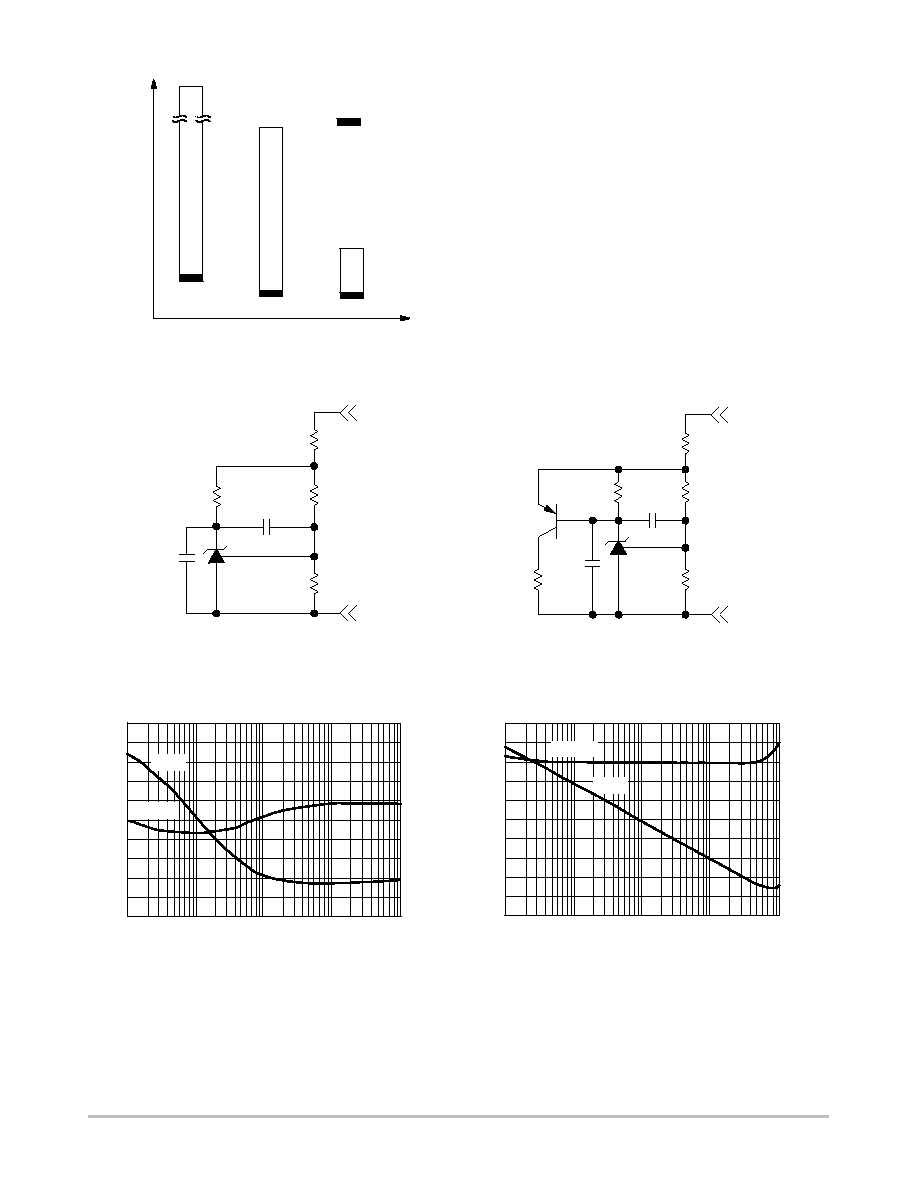
AND8031/D
http://onsemi.com
4
TL431
TLV431
NCP100
36
3.75
3.2
16
2.5
1.95
6.0
2.15
1.6
Extended
Range with
PNP
Figure 6. Power Supply Output Voltage Range
Comparison for Programmable Precision References
Power Supply Ideal
Output V
oltage Range (V)
Figure 5 illustrates an additional 1.0 uF capacitor, C3,
which is required for normal operation of the NCP100.
Bandwidth concerns are raised when a capacitor is placed
from the cathode to anode of the precision reference. Since
the PNP transistor is used to drive the optocoupler, the
cathode current of the NCP100 is amplified by the beta of the
transistor therefore minimizing the effects of C3. R3 is a
factor in the overall gain of the feedback network and R4
limits the current into the diode of the optocoupler. The
roll¡off frequency of the feedback network is related to R1
and C2 only. Figure 7 shows the circuit schematic, the gain
and the phase of the TLV431 and the NCP100 with and
without the PNP.
R1
U1
R2
C2
V
out
GND
R3
R1
C3
Q1
U1
R2
C2
V
out
GND
R3
R4
C3
R
OSC
R
OSC
Figure 7. Schematics for Gain and Phase Comparison of TLV431 and NCP100
Note: C3 only for NCP100
20
0
30
¡10
10
¡20
40
40
70
60
Figure 8. TLV431 with PNP
50
Figure 9. TLV431 without PNP
Gain
Phase
Gain
Phase
¡30
180
90
0
¡90
¡180
PHASE (
░
)
GAIN (dB)
180
90
0
¡90
¡180
GAIN (dB)
PHASE (
░
)
10
100
1 k
10 k
100 k
Frequency (Hz)
10
100
1 k
10 k
100 k
Frequency (Hz)
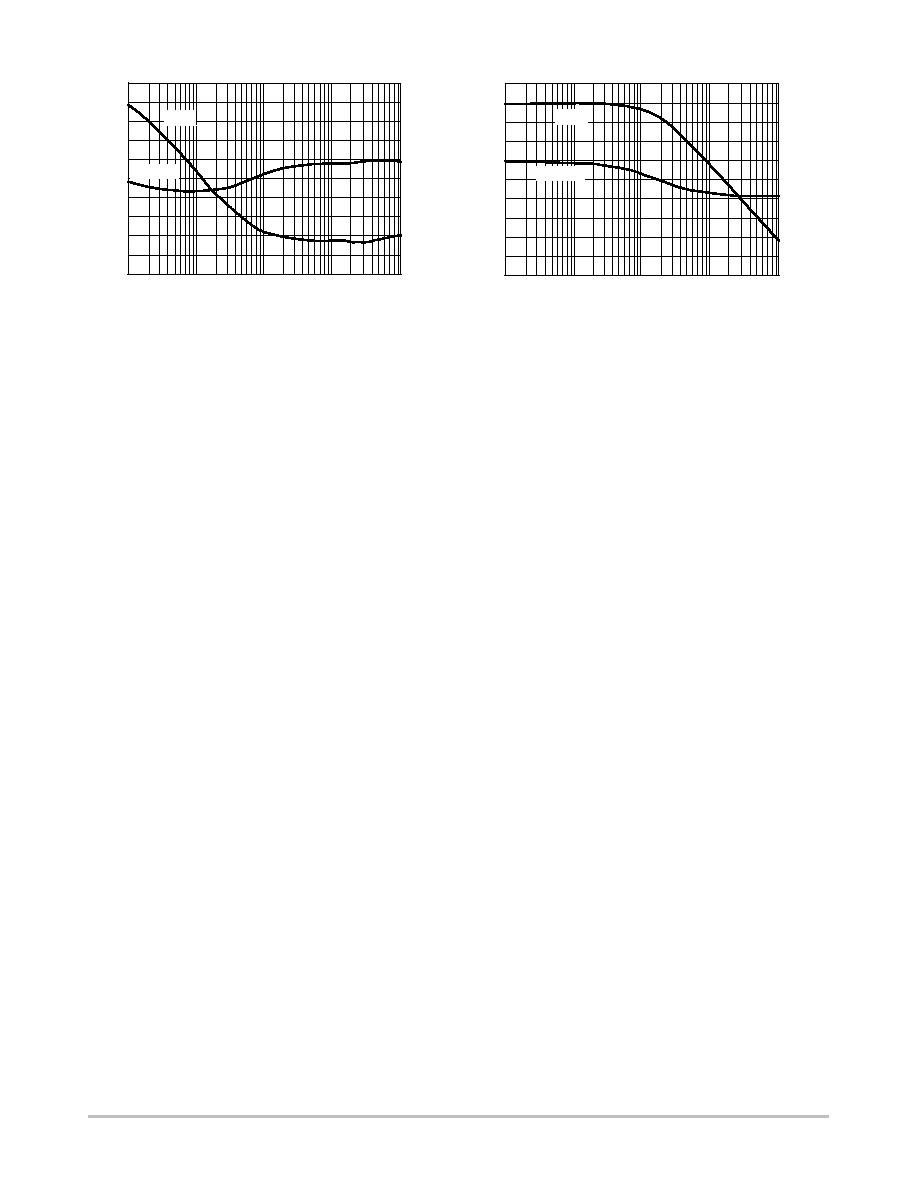
AND8031/D
http://onsemi.com
5
60
50
40
30
20
10
Figure 10. NCP100 with PNP
Figure 11. NCP100 without PNP
Gain
Phase
¡20
¡40
¡10
¡30
0
Gain
Phase
GAIN (dB)
180
90
0
¡90
¡180
PHASE (
░
)
GAIN (dB)
PHASE (
░
)
180
90
0
¡90
¡180
10
100
1 k
10 k
100 k
Frequency (Hz)
10
100
1 k
10 k
100 k
Frequency (Hz)
The values for the components in Figure 7 are as follows.
Rosc = 12 Ohms, R1 = 12 k Ohms, R2 is adjustable
dependant upon U1, R3 and R4 = 100 Ohms, C2 = 0.01 uF,
and C3 = 1.0 uF.
The open loop gain and phase test injects the oscillator
signal across Rosc. The reference voltage is measured
between Rosc and R1 to ground. The test voltage is
measured at the collector of Q1 for the PNP circuit or at the
cathode of U1 for the traditional circuit. Vout is set to 4.0
volts and R2 is adjusted so the DC test voltage is at the center
of its range. R2 is the only component adjusted since it is
neglected for AC analysis.
There are negligible differences for the open loop gain and
phase of the NCP100 with C3 compared to the TLV431
without C3 in the PNP circuit. Therefore there is no penalty
with the added C3 in the NCP100 circuit.
If the PNP transistor is removed, the TLV431 open loop
responses with and without C3 are very similar with a single
pole roll¡off. The pole appears to be near 4 Hz.
The NCP100 without the PNP has flat gain until a pole at
1.3 kHz due to R1 and C2. The plot remains at
¡20 dB/decade and ¡90 degree phase margin until well
beyond 100 kHz.
The overall gain of the feedback network can be limited
due to R1, R3 and C2 in Figure 7 . Varying these components
will modify the maximum gain of the system.
Since the NCP100 provides a single pole roll¡off, the
MC33363B compensation pin will not provide this function.
The feedback pin of the MC33363B is connected directly to
the reference pin. This will keep the output of the error amp
low. A diode is in series with the output of the op¡amp
allowing the compensation pin to directly control the
feedback to the oscillator ramp. The compensation pin is
connected to the feedback pin via a 2.7 k Ohm resistor. The
collector of the optocoupler is also connected to the
compensation pin and the emitter is grounded. This
completes the design of the system. See Figure 14 for the
board layout of the schematic in Figure 1 and Table 1 for the
component values.
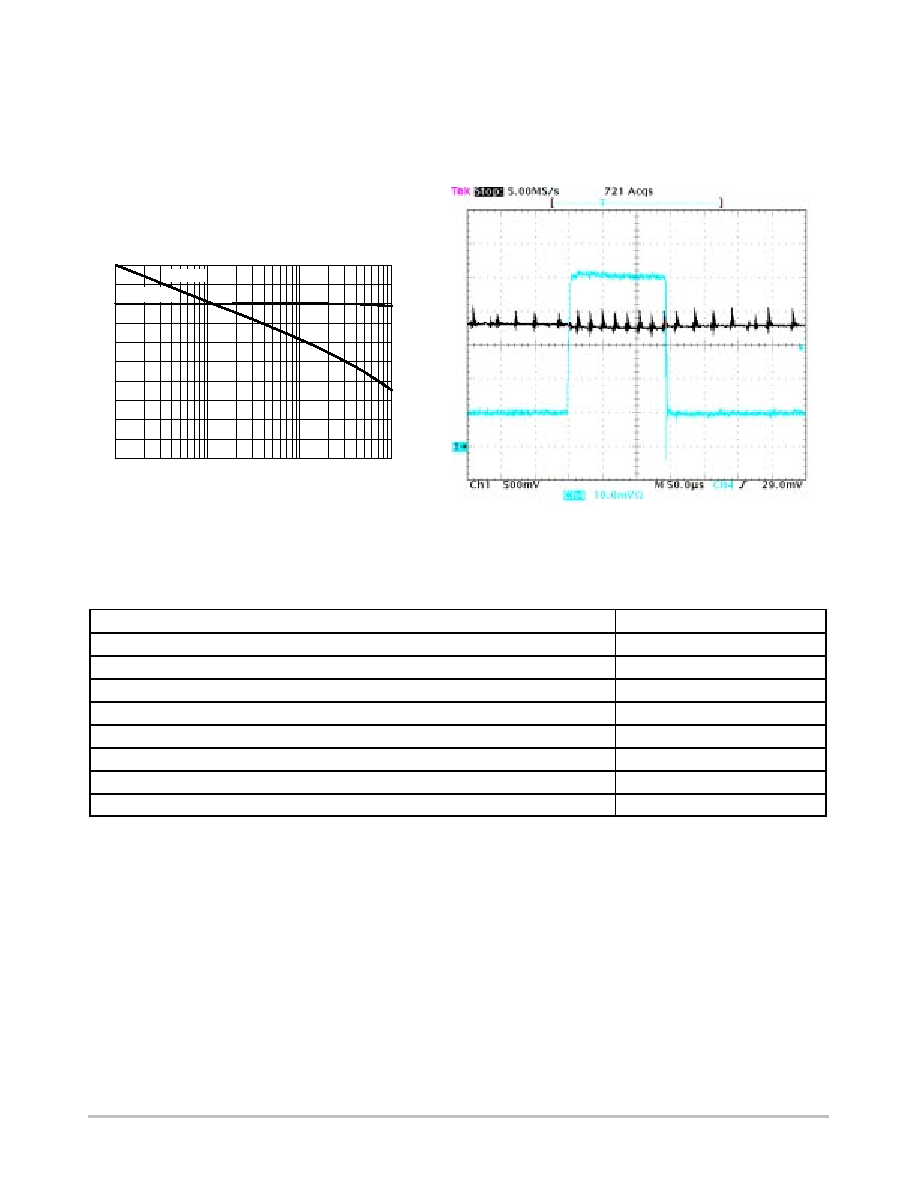
AND8031/D
http://onsemi.com
6
Results
Table A lists the system parameters. Figure A illustrates
the single pole feedback from the circuit in Figure 1 and the
layout in Figure 13. The output current step response has a
negligible effect on the output voltage. Figure B is the output
step response of the circuit from 20% to 100%. The circuit
performance achieves the desired results for the off¡line
converter. The efficiency is low, but is expected for a low
power off¡line converter.
Figure 12. Gain and phase results from the 1.8 volt
1 ampere off¡line converter.
Figure 13. Output step response from 0.2 to 1.0
Amperes.
10 Hz
0
10 kHz
¡20
1 kHz
100 Hz
¡40
20
Gain
Phase
180
90
0
¡90
¡180
PHASE (
░
)
Table 1. System Parameters
Parameter
Value
Operating Frequency
110 kHz
Primary Peak Current Limit
230 mA
Efficiency at 1.0 Ampere Load, 120 VACin
58.6 %
Efficiency at 1.0 Ampere Load, 230 VACin
57.2 %
Load Regulation, 120 VACin, 0.1 to 1.0 Ampere Load
22 mV
Line Regulation, 1.0 Ampere Load, 90 to 265 VACin
1 mV
Low Frequency Output Ripple, 1.0 Ampere Load
43 mVpp
High Frequency Output Ripple, 1.0 Ampere Load
350 mVpp

AND8031/D
http://onsemi.com
7
Figure 14. Layout of Off Line Power Supply

AND8031/D
http://onsemi.com
8
Table 2. Component Values of Off¡Line Power Supply
Reference
Part
Description
Manufacturer
C1
1 n
X Capacitor
C2
4.7 u
400 Volt Bulk YK Series
Rubycon
C3
390 p
SMT Ceramic 0805
TDK
C4,C10,C12
1 u
SMT Ceramic 1206
TDK
C5
47 p
1 k Volt Ceramic Disc
C6
10 u
25 Volt MS5 Series
Rubycon
C7,C8
820 u
6.3 Volt YXG Series
Rubycon
C9,C11
0.1 u
Y Capacitor
TDK
D1,D2,D3,D4
1N4005
Standard Recovery Rectifiers
ON Semiconductor
D5
MURS160T3
600 Volt Ultra Fast Rectifier
ON Semiconductor
D6
MURS120T3
200 Volt Ultra Fast Rectifier
ON Semiconductor
D7
MBRD835L
35 Volt Schottky Rectifier
ON Semiconductor
JP1,JP2
3.5 mm 2 Pole Connector
Wieland
Q1
BC858ALT1
Small Signal PNP
ON Semiconductor
R1,R2
4.7
SMT 0805
R3
30 k
SMT 0805
R4
3.9 k
1/4 Watt
R6
2.7 k
SMT 0805
R9
12 k
SMT 1206
R10
7.5 k
SMT 0805
R11
10
SMT 0805
R12
120
SMT 0805
U1
MC33363BDW
SMPS Controller with FET
ON Semiconductor
U2
Transformer
Transformer EE16 CTX22¡14966
Coiltronics
U3
SFH615¡4
4 pin Optocoupler
U4
NCP100
Programmable Precision Reference
ON Semiconductor
References
1. Brown, Marty, Power Supply Cookbook, Newton, MA,
Butterworth¡Heinemann, 1994.
2. Basso, Christophe, Application Note: "AND8023:
Implementing the NCP1200 in Low¡Cost AC/DC
Converters,'' ON Semiconductor, August, 2000.

AND8031/D
http://onsemi.com
9
Notes

AND8031/D
http://onsemi.com
10
Notes

AND8031/D
http://onsemi.com
11
Notes

AND8031/D
http://onsemi.com
12
ON Semiconductor and are trademarks of Semiconductor Components Industries, LLC (SCILLC). SCILLC reserves the right to make changes
without further notice to any products herein. SCILLC makes no warranty, representation or guarantee regarding the suitability of its products for any particular
purpose, nor does SCILLC assume any liability arising out of the application or use of any product or circuit, and specifically disclaims any and all liability,
including without limitation special, consequential or incidental damages. "Typical" parameters which may be provided in SCILLC data sheets and/or
specifications can and do vary in different applications and actual performance may vary over time. All operating parameters, including "Typicals" must be
validated for each customer application by customer's technical experts. SCILLC does not convey any license under its patent rights nor the rights of others.
SCILLC products are not designed, intended, or authorized for use as components in systems intended for surgical implant into the body, or other applications
intended to support or sustain life, or for any other application in which the failure of the SCILLC product could create a situation where personal injury or
death may occur. Should Buyer purchase or use SCILLC products for any such unintended or unauthorized application, Buyer shall indemnify and hold
SCILLC and its officers, employees, subsidiaries, affiliates, and distributors harmless against all claims, costs, damages, and expenses, and reasonable
attorney fees arising out of, directly or indirectly, any claim of personal injury or death associated with such unintended or unauthorized use, even if such claim
alleges that SCILLC was negligent regarding the design or manufacture of the part. SCILLC is an Equal Opportunity/Affirmative Action Employer.
PUBLICATION ORDERING INFORMATION
CENTRAL/SOUTH AMERICA:
Spanish Phone: 303¡308¡7143 (Mon¡Fri 8:00am to 5:00pm MST)
Email: ONlit¡spanish@hibbertco.com
Toll¡Free from Mexico: Dial 01¡800¡288¡2872 for Access ¡
then Dial 866¡297¡9322
ASIA/PACIFIC: LDC for ON Semiconductor ¡ Asia Support
Phone: 303¡675¡2121 (Tue¡Fri 9:00am to 1:00pm, Hong Kong Time)
Toll Free from Hong Kong & Singapore:
001¡800¡4422¡3781
Email: ONlit¡asia@hibbertco.com
JAPAN: ON Semiconductor, Japan Customer Focus Center
4¡32¡1 Nishi¡Gotanda, Shinagawa¡ku, Tokyo, Japan 141¡0031
Phone: 81¡3¡5740¡2700
Email: r14525@onsemi.com
ON Semiconductor Website: http://onsemi.com
For additional information, please contact your local
Sales Representative.
AND8031/D
NORTH AMERICA Literature Fulfillment:
Literature Distribution Center for ON Semiconductor
P.O. Box 5163, Denver, Colorado 80217 USA
Phone: 303¡675¡2175 or 800¡344¡3860 Toll Free USA/Canada
Fax: 303¡675¡2176 or 800¡344¡3867 Toll Free USA/Canada
Email: ONlit@hibbertco.com
Fax Response Line: 303¡675¡2167 or 800¡344¡3810 Toll Free USA/Canada
N. American Technical Support: 800¡282¡9855 Toll Free USA/Canada
EUROPE: LDC for ON Semiconductor ¡ European Support
German Phone: (+1) 303¡308¡7140 (Mon¡Fri 2:30pm to 7:00pm CET)
Email: ONlit¡german@hibbertco.com
French Phone: (+1) 303¡308¡7141 (Mon¡Fri 2:00pm to 7:00pm CET)
Email: ONlit¡french@hibbertco.com
English Phone: (+1) 303¡308¡7142 (Mon¡Fri 12:00pm to 5:00pm GMT)
Email: ONlit@hibbertco.com
EUROPEAN TOLL¡FREE ACCESS*: 00¡800¡4422¡3781
*Available from Germany, France, Italy, UK, Ireland











